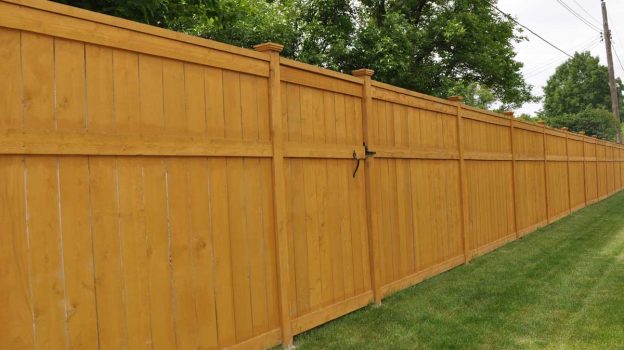Leading Wood Fence Builders Fort Smith AR: Building Lasting Fences for Your Property
Leading Wood Fence Builders Fort Smith AR: Building Lasting Fences for Your Property
Blog Article
Step-by-Step Overview to Installing a Wood Fencing for Your Home or Building
Mounting a timber fence can dramatically improve both the capability and aesthetic allure of your property. Understanding these steps not just makes certain a tough setup yet also contributes to lasting complete satisfaction.
Preparation Your Fencing Setup
When starting the installation of a wood fence, careful planning is important to ensure a successful outcome. Begin by evaluating the objective of the fence-- whether it is for privacy, safety and security, or aesthetic appeals-- since this will affect the style and format. Next off, examine the residential or commercial property lines, making sure to confirm the borders via a study or title deed to stay clear of disputes with next-door neighbors.
Think about regional zoning homeowners and regulations' organization guidelines, as these may determine fence elevation, style, and products. It is a good idea to obtain the required licenses before commencing work, as this can stop lawful problems later on.
Moreover, take into account the terrain and dirt conditions of your building. Unequal ground may need added modifications throughout installment, while rough soil could require specific devices.
Lastly, produce a detailed plan that consists of measurements, the number of posts, and the spacing in between them. A clear design will certainly assist in the setup procedure and make certain that you have actually all called for products accessible. By adhering to these planning steps, you can set a strong structure for an effective timber fence setup.
Selecting the Right Materials
Selecting the appropriate products for your timber fence is vital to ensuring longevity and aesthetic allure. The most usual kinds of timber utilized for fencing include cedar, redwood, and pressure-treated want.
Pressure-treated ache is one more prominent option, as it is often more budget friendly. However, it needs normal upkeep and treatment to prolong its life-span. When selecting wood, consider the climate of your region; for instance, locations with high moisture may profit from timber varieties with higher resistance to dampness.
In addition, you need to examine the fencing design and function. A picket fencing may call for various product specs compared to a privacy fence. Choose thicker boards for architectural integrity, specifically in high-wind locations. Consider the surface; neglected wood may call for staining or securing to safeguard versus weather aspects. By very carefully choosing your products, you can guarantee that your timber fence will certainly stand the examination of time while matching your home's landscape.
Preparing the Setup Site

Preparing the installation website is a vital action in guaranteeing the successful building and construction of your wood fence. Proper preparation not just helps with a smoother installment process however also adds to the longevity and stability of the fence.

If your site has uneven ground, think about leveling it or changing your fence style accordingly. This is necessary to prevent damage during installment and ensure safety.
Setting Up the Fencing Posts

Next, dig holes for each post, ensuring they are deep enough-- usually one-third the elevation of the post over ground-- to give stability. A depth of a minimum of 2 feet is advisable for most fencings. The size of the investigate this site holes should be roughly 3 times the size of the articles.
Once your openings prepare, location each message upright right into the marked opening. Utilize a degree to guarantee they are plumb, readjusting as essential. After placing, fill the holes with concrete mix or stuffed dirt for included assistance. Allow the concrete to heal based on the manufacturer's directions, typically 24 to 2 days. Effectively set up messages are essential for keeping the structural honesty of the fence, guaranteeing it continues to be upright and safe versus environmental anxieties.

Including Fencing Panels and Ending Up Touches
Once the fence messages are safely established, the next action entails attaching the fencing panels, which will certainly define the limits of your building. Begin by placing each panel in between the posts, guaranteeing they are level and straightened. Utilize a level device to inspect that the panels are right; this will guarantee an expert finish. For optimal stability, safe each panel to the articles making use of galvanized screws or nails, which stand up to rust and deterioration.
After all panels are connected, inspect the entire fencing for any misalignments or voids. Make modifications as essential to guarantee an uniform look.
Furthermore, using a safety discolor or sealant will enhance the wood's longevity against weather elements, extending the life of your fence. With these steps, your timber fencing will not only serve its purpose effectively yet also boost the general appeal of your property.
Verdict
To conclude, the effective setup of a wood fencing calls for mindful preparation, option of appropriate products, detailed site preparation, and exact implementation of installment strategies. Interest to information during each phase ensures structural integrity and aesthetic charm. By sticking to the detailed actions, homeowner can improve privacy, safety, and curb allure, inevitably contributing to the overall value and performance of the residential or commercial property. Proper maintenance post-installation even more prolongs the life and look of the timber fencing.
When beginning on the setup of a timber fence, cautious preparation is important to guarantee a successful outcome.Selecting the proper products for your timber fencing is essential to making sure sturdiness and visual appeal. A picket fence might need various product requirements compared to a personal privacy fence.With the installment site properly prepared, the next step involves establishing the fencing blog posts, which offer as the foundation of your timber fence.Once the fencing messages are securely set, the next Bonuses step includes attaching the fencing over at this website panels, which will certainly define the borders of your building.
Report this page